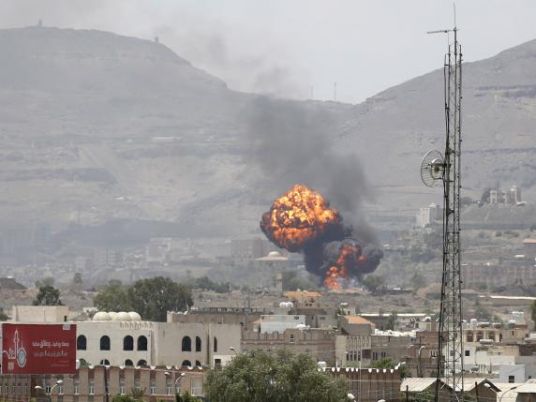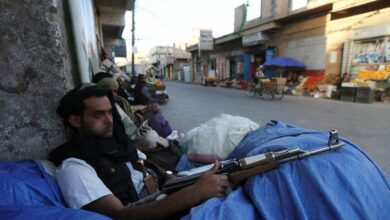
As Gulf Arab troops push through Yemen's central desert into the mountains that lead to the capital held by the Houthis, their Iran-allied foe, winning the hearts and minds of the heavily armed tribes who rule in this area is essential.
The loyalties of the province, whose modest oil wealth is important to Yemen where even before the war over half the population lived in poverty, are divided.
Most of its famously tough clans are now allies of the wealthy Gulf states, but the Houthis, mostly members of Yemen's Zaydi Shi'ite sect, which is distinct from the version in Iran, and army units loyal to former President Ali Abdullah Saleh also have friends there.
Yemeni tribal irregulars — many of them barely out of adolescence — drive around the sand-blown roads on the outskirts of the Gulf Arabs' base at Safer and are a vital, if far less organized and well-armed, part of the war effort.
One Emirati soldier operating at the Saudi-led Arab coalition base at Safer said the force relied on local Yemeni fighters to guard the site but only at the outer perimeter.
The Gulf Arab troops have been careful about congregating in one place since a missile attack by the Houthis earlier this month killed at least 60 Emirati, Saudi and Bahraini men. They now sleep mostly separately and gather in smaller groups.
Some Yemenis from Marib, the area's main town, speculate that the new policy might have been implemented out of fear that Yemeni informants had tipped the Houthis off to the base's location ahead of the September 4 missile strike.
The UAE pays local combatants hundreds of dollars a month each, according to one Emirati soldier, a considerable sum in the poorest Arab country. The coalition also distributed new assault rifles and ammunition belts, but the Yemenis still clamoured for more, the soldier said.
"We give them a lot, but they say 'I need more guns, more body armour, and oh, a Toyota Hilux (pick-up), but it has to be a 2015 model!'" he joked.
The Houthis, with help from Saleh loyalists in the military, pushed south from their northern stronghold last year to seize the capital Sanaa, before striking quickly this spring towards Aden, the last city held by President Abd-Rabbu Mansour Hadi.
Saudi Arabia, which fears that its main enemy Iran would use Houthi control in Yemen to undermine Riyadh's own stability, gathered a coalition of Arab countries backed by the West to push back the Houthis and restore Hadi.
After months of intense air strikes and territorial stalemate, they recaptured Aden and its surrounding area in July and have now pushed from the Saudi border into Marib, east of Sanaa, as a launchpad for a thrust towards the capital Sanaa.
INDISCIPLINE AND GOOD HUMOUR
Some of the Gulf Arab troops were sharply critical of the tribal irregulars, questioning their fighting ability and their unruly approach to tactics.
"They're nuts. They fire around indiscriminately – not disciplined fighters. I don't like to fight where they are," said another soldier, who declined to be named but said he had served in Afghanistan.
Far from the base, Hassan Taleb, a Marib tribesmen, accepted the charge of indiscipline in good humour.
"It's true, there's no real order when tribesmen do combat, it's just the local style," said Taleb, clad in a grey robe and headscarf.
He had bought his flashy new bullet belt himself, he insisted, from Marib's thriving black market. But he and his fellow fighters agreed that Gulf Arab help has improved their fighting ability.
"They give aid, weapons and salaries, but in a responsible way … through our sheikhs (leaders)," Taleb said. "In the end we buy most of our things ourselves and fight with our Arab brothers against the same threat, the Houthi militias."
Capturing Marib, which is not only strategically important, but symbolically resonant across the region, is important for a coalition which sees its campaign as restoring bygone Arab unity, this time against the influence of Persian-speaking Iran.
ORIGINAL ARAB HOMELAND
According to folklore, Marib was the original Arab homeland, and its people only spread across the Arabian Peninsula after the area's ancient dam, constructed more than 2,000 years ago and the source of its lush agricultural wealth, burst.
Distant shudders from explosions, either air strikes or artillery, now echo from the gap in mountains where a new dam, partly paid for by the founder of the UAE Sheikh Zayed bin Sultan Al Nahyan in the 1980s, stands near the ruins of the old.
A couple of dozen kilometres away from the dam, the nearly 3,000-year-old temple famed to have been built by the Queen of Sheba stands as another forgotten relic of "Happy Arabia", as Yemen was once known.
Far before the conflict erupted on its doorstep, the site had been abandoned by foreign tourists after several Spanish tourists and Yemenis in 2007 were killed in a suicide bombing claimed by al Qaeda.
"The dam and the temple of the sun here have writings carved by our old tribes, our ancestors," said Ali Ahmed Abdullah, a lone caretaker at the site with a grey beard.
"God willing, and with the help of the other Arabs, we will have victory and Yemen will return to being great again."




